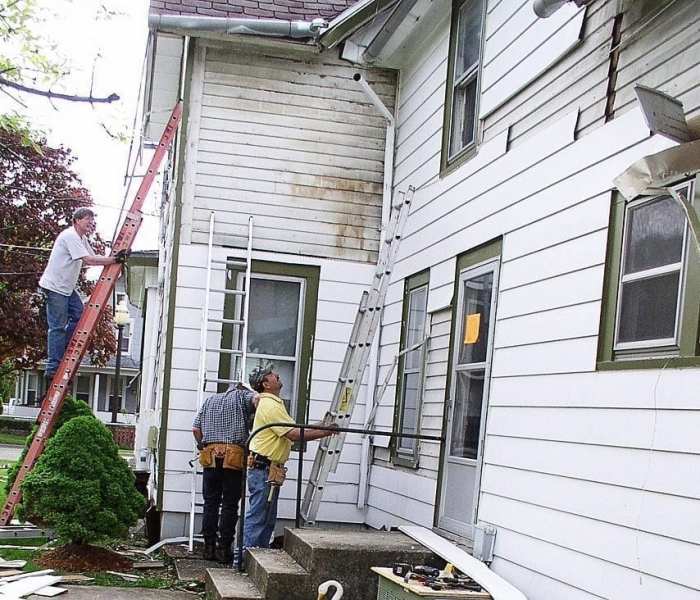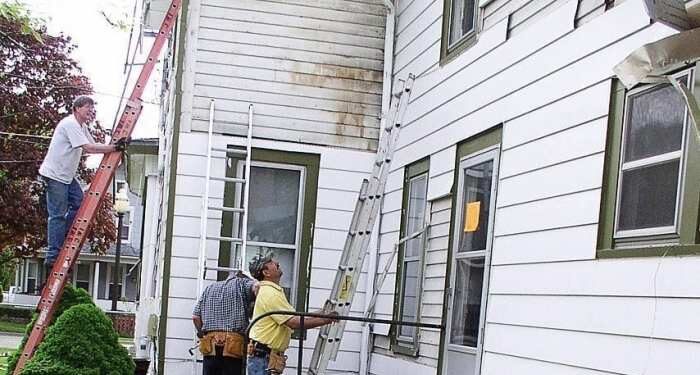Exploring the cost implications of installing vinyl siding over asbestos shingles opens up a world of possibilities and considerations. From understanding the process to weighing the environmental and safety factors, this guide will delve into all aspects of this home improvement project.
As we navigate through the intricacies of cost factors, environmental concerns, and long-term durability, you'll gain valuable insights to make informed decisions for your siding project.
Vinyl Siding Installation Over Asbestos Shingles
When it comes to installing vinyl siding over existing asbestos shingles, there are specific steps that need to be followed to ensure a successful outcome.
Preparing the Surface for Vinyl Siding Installation
Before installing vinyl siding over asbestos shingles, the surface needs to be properly prepared to ensure a smooth and long-lasting finish. Here are the steps involved:
- Inspect the asbestos shingles for any damage or signs of wear. Replace any damaged shingles to create a stable base for the vinyl siding.
- Clean the surface thoroughly to remove dirt, dust, and any other debris that could affect the adhesion of the vinyl siding.
- Apply a layer of house wrap or foam insulation board to improve the insulation and energy efficiency of the home.
- Install furring strips vertically over the asbestos shingles to create a level surface for the vinyl siding to be attached.
- Finally, install the vinyl siding according to the manufacturer's instructions, ensuring proper overlap and sealing to prevent water infiltration.
Benefits and Drawbacks of Putting Vinyl Siding Over Asbestos Shingles
There are both advantages and disadvantages to consider when opting to put vinyl siding over existing asbestos shingles:
- Benefits:
- Vinyl siding can improve the aesthetics of the home, giving it a fresh and modern look.
- It can provide additional insulation, helping to reduce energy costs and increase the home's energy efficiency.
- Vinyl siding is low maintenance and durable, lasting for many years without the need for frequent painting or upkeep.
- Drawbacks:
- Installing vinyl siding over asbestos shingles can add extra weight to the structure, potentially causing issues if not properly supported.
- Moisture can become trapped between the vinyl siding and asbestos shingles, leading to mold or mildew growth if not properly addressed.
- The cost of installing vinyl siding over asbestos shingles can be higher than other siding options due to the additional preparation required.
Cost Factors to Consider
When considering putting vinyl siding over asbestos shingles, there are several key cost factors to take into account. Installing vinyl siding over asbestos shingles can be a cost-effective alternative to removing the asbestos shingles first. The cost of removing asbestos shingles can be quite high due to the specialized equipment, safety measures, and disposal requirements involved.
By opting to install vinyl siding over the existing shingles, you can potentially save on the high costs associated with asbestos removal.
Labor Costs
Labor costs play a significant role in the overall project cost. When installing vinyl siding over asbestos shingles, labor costs may vary depending on the complexity of the job, the size of the property, and the experience of the contractors.
It is essential to obtain multiple quotes from reputable contractors to ensure you are getting a fair price for the labor involved.
Material Costs
The cost of materials is another crucial factor to consider when putting vinyl siding over asbestos shingles. The price of vinyl siding can vary based on the quality, color, and style chosen. Additionally, you may need additional materials such as insulation, trim pieces, and fasteners.
It is essential to factor in all material costs to accurately estimate the total project cost.
Additional Expenses
In addition to labor and material costs, there may be additional expenses to consider when installing vinyl siding over asbestos shingles. These expenses can include permit fees, disposal fees for any waste generated during the project, and potential repairs or modifications needed to ensure the vinyl siding is properly installed.
It is crucial to account for these additional expenses to avoid any surprises during the project.
Environmental and Safety Considerations
When considering covering asbestos shingles with vinyl siding, it is crucial to take into account the environmental impact of such a project, as well as the safety measures that need to be implemented to protect the health of individuals involved in the installation process.
Environmental Concerns
- Asbestos is a hazardous material that can pose serious health risks if disturbed. Covering asbestos shingles with vinyl siding may encapsulate the asbestos fibers, preventing them from being released into the environment. However, if the siding is not installed properly or becomes damaged over time, it could lead to the release of asbestos fibers.
- Disposing of asbestos-containing materials, such as the old shingles, also requires proper handling and disposal methods to prevent contamination of the surrounding environment.
Safety Measures
- Before starting the installation process, it is essential to conduct a thorough inspection of the asbestos shingles to assess their condition. If the shingles are damaged or deteriorating, it is crucial to hire professionals with expertise in asbestos removal to safely mitigate the risks.
- During the installation of vinyl siding, workers should wear appropriate personal protective equipment, such as respirators and protective clothing, to minimize exposure to asbestos fibers.
- Proper containment measures should be put in place to prevent the spread of asbestos particles during the removal or covering process. This includes sealing off the work area and using HEPA vacuums to clean up any debris.
Regulations and Guidelines
- When working with asbestos-containing materials, it is important to comply with regulations set forth by local, state, and federal authorities. These regulations may include requirements for asbestos testing, removal procedures, and disposal methods.
- Following guidelines established by organizations such as the Environmental Protection Agency (EPA) and the Occupational Safety and Health Administration (OSHA) can help ensure that the project is carried out safely and in accordance with applicable laws.
Long-Term Durability and Maintenance

Vinyl siding offers excellent durability when installed over asbestos shingles compared to other siding options. The vinyl material is resistant to rot, insect damage, and warping, making it a long-lasting choice for your home exterior.
Durability Comparison
- Vinyl siding is known for its longevity, with a lifespan of 20 to 40 years when properly maintained.
- Compared to wood siding, vinyl requires less maintenance and is not susceptible to moisture-related issues like rotting or swelling.
- When installed correctly over asbestos shingles, vinyl siding can provide a protective barrier that enhances the overall durability of your home's exterior.
Maintenance Tips
- Regularly clean the vinyl siding with a mixture of water and mild detergent to remove dirt and grime.
- Inspect the siding for any signs of damage, such as cracks or loose panels, and repair them promptly to prevent further issues.
- Avoid using abrasive cleaners or tools that could scratch the surface of the vinyl siding.
Impact of Weather Conditions
- Extreme weather conditions, such as high winds, heavy rain, or hail, can affect the lifespan of vinyl siding over asbestos shingles.
- Proper installation techniques, including securing the siding properly and ensuring adequate insulation, can help mitigate the impact of weather on the siding.
- Regular maintenance, especially after severe weather events, is essential to ensure the longevity of vinyl siding over asbestos shingles.
Summary
In conclusion, the decision to put vinyl siding over asbestos shingles involves careful planning and consideration of various elements. By weighing the costs, environmental impact, and maintenance requirements, you can ensure a successful and durable outcome for your home's exterior.
Popular Questions
What are the key cost factors to consider when putting vinyl siding over asbestos shingles?
The key cost factors include labor costs, material costs, and any additional expenses such as surface preparation or disposal of asbestos shingles.
How does the cost of installing vinyl siding over asbestos shingles compare to removing the asbestos shingles first?
Installing vinyl siding over asbestos shingles is generally more cost-effective than removing the asbestos shingles first, as it eliminates the need for costly abatement procedures.
What environmental concerns are associated with covering asbestos shingles with vinyl siding?
There may be concerns about encapsulating asbestos fibers and potential issues with disposal when covering asbestos shingles with vinyl siding.
Are there specific safety measures that need to be taken during the installation process?
Safety measures such as wearing protective gear, minimizing dust exposure, and proper handling of materials are essential to minimize health risks during installation.
How can weather conditions impact the longevity of vinyl siding over asbestos shingles?
Extreme weather conditions like intense heat or cold can affect the expansion and contraction of vinyl siding, potentially impacting its lifespan when installed over asbestos shingles.














